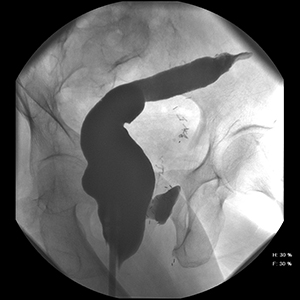What Is a Fistula?

A fistula is an abnormal hole in the bowel or the bladder. A recto-urethral fistula is a hole between the urethra (urinary channel) and the rectum. This hole leads to leakage of urine into the rectum and feces travelling into the bladder.
How Do I Know if I Have a Fistula?
One of the telltale signs of a fistula is urine leaking out the rectum. Another sign is severe urinary tract infections. Patients can sometimes become very ill at the time of diagnosis of this fistula.
What Causes a Fistula?
The most common cause of this problem is one of the following:
- Surgery on the bowel
- Surgery on the cervix or uterus
- Treatment for prostate cancer; treatments for prostate cancer that can cause a fistula include any form of radiation therapy, cryotherapy, radical prostatectomy, and high intensity focused ultrasound.
Find a Urology Specialist
What Happens After a Fistula Is Diagnosed?
It is important to divert the flow of feces away from the urinary tract and treat infections when a fistula is first diagnosed. Feces are diverted in a procedure called a colostomy.
Colostomy
In this surgery the colon or small bowel is brought up to the skin and sewn in place. A stoma bag is pasted to the skin to collect the feces. This is a temporary measure until infection can be treated and the fistula is repaired.
Often patients need to wait between the colostomy placement and the fistula repair to allow infection and inflammation to resolve. Occasionally fistula will heal spontaneously with only the colostomy surgery.
Treatments for Recto-Urethral Fistula


The treatment of a recto-urethral fistula is not easy. Each fistula is different and needs to be fully evaluated. Most fistulas can be treated by closure of the fistula and placement of a muscle flap from the leg between the rectum and the urethra. This muscle flap is essential to allow for healthy healing of this area. The hole in the rectum can also for the most part be simply closed.
In some cases of large fistula, a piece of the lining of the inner cheek, called buccal mucosa, is used to close the hole in the prostate and urethra. The lining of the inner cheek is very similar to the lining of the urethra. This surgery takes several hours and the recovery will take many weeks afterward, but it is one of the only reliable ways of getting these fistula to close.
Is Recovery From Surgery Difficult?
The recovery from this type of surgery is difficult. There are incisions that are extensive and adequate time must go by before removal of catheters from the urinary system. Usually, this is four to six weeks. Once the fistula has healed and an adequate time has passed to make sure the hole will not recur than the colostomy can be reversed. This time frame is usually about three to six months after removal of all the urinary catheters.
During this post-operative period, patients are followed very closely by Dr. Myers and the staff at University of Utah Health. Follow up with an outside urologist can also usually also be arranged in close conjunction with our hospital. This can be done throughout the nation.
